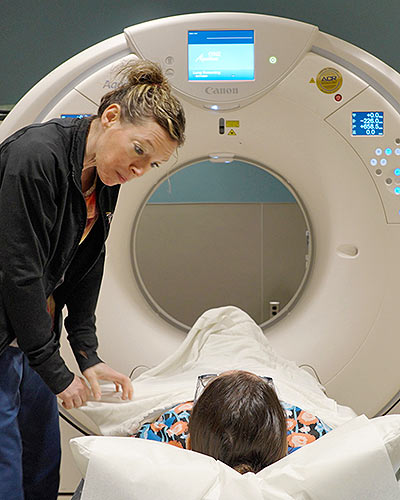August 10, 2017 | David Kohn

Findings Suggest Treatment is Effective Compared to Standard Radiation
Proton-beam radiotherapy is safe and appears to be effective in treating some cases of small cell lung cancer (SCLC), an aggressive cancer that accounts for about 10 to 15 percent of all lung cancers, according to a new study published online in the journal Cancer.
The study of 30 patients is the first prospective study for SCLC to evaluate clinical outcomes and adverse effects of proton therapy, a precise form of radiation therapy that deposits all of its energy within the tumor and causes less collateral damage to normal tissues around the tumor. Patients in the study had localized cancer that had not spread to other parts of the body.
“Radiation therapy is essential to the management of limited-stage small cell lung cancer, but when it is combined with chemotherapy, it can result in substantial toxicities, increasing the risk to critical organs such as the lungs, heart and esophagus,” says Charles B. Simone, II, MD, associate professor of radiation oncology at the University of Maryland School of Medicine and Medical Director of the Maryland Proton Treatment Center, who is the senior author of the study.
Studies have demonstrated that proton therapy can reduce the radiation dose to these healthy organs in patients with non-small cell lung cancer (NSCLC), the most common form of lung cancer, but there previously were no comparable data for small cell lung cancer, Dr. Simone notes. “We wanted to assess the safety and preliminary efficacy of combining proton-beam therapy with chemotherapy to treat this very challenging type of lung cancer, which is particularly important since patients with small cell lung cancer often present with larger tumors and are sicker at diagnosis than their non-small cell counterparts” he says.
The researchers found that the combination therapy produced a lower incidence of adverse side effects than would be expected with standard photon therapy while maintaining similar clinical outcomes. They also reported “statistically significant” reductions in radiation doses to the spinal cord, lungs and heart compared to the doses that would have been delivered with standard radiation therapy. They performed this analysis by comparing proton therapy with clinical backup plans for each patient using intensity-modulated radiotherapy (IMRT) with photon therapy.
“We are very encouraged by these findings but hope that this study serves as a platform on which to build larger clinical investigations,” Dr. Simone says. “We need multi-center studies to further evaluate the effectiveness of proton therapy for small cell lung cancer patients.”
 The majority of the patients in the study were women; the median age was 68 years old. All had a significant history of smoking. After the treatment, 27 patients were evaluated: 11 had a complete response, 15 had a partial response and one had stable disease. The patients were followed for a median 14 months. The median disease-free survival was 14.3 months, and the median overall survival was 28.2 months. Side effects included inflammation of the lungs or esophagus, fatigue and anorexia, but only a few serious adverse events were reported.
The majority of the patients in the study were women; the median age was 68 years old. All had a significant history of smoking. After the treatment, 27 patients were evaluated: 11 had a complete response, 15 had a partial response and one had stable disease. The patients were followed for a median 14 months. The median disease-free survival was 14.3 months, and the median overall survival was 28.2 months. Side effects included inflammation of the lungs or esophagus, fatigue and anorexia, but only a few serious adverse events were reported.
The team of researchers concluded: “Proton-beam therapy as part of a combined modality therapy for LS-SCLC is feasible and safe, with preliminary evidence showing encouraging efficacy in comparison with photon radiation.”
The research was conducted at the University of Pennsylvania, where Dr. Simone was on the faculty before coming to University of Maryland School of Medicine in 2016. The lead author is Jean-Claude M. Rwigema, MD.
“Although this is a small study, it is an important first step in evaluating the safety and effectiveness of proton therapy to treat patients with this aggressive lung cancer,” says E. Albert Reece, MD, PhD, MBA, vice president for medical affairs at the University of Maryland, who is the John Z. and Akiko K. Bowers Distinguished Professor and dean of the School of Medicine. “We believe that proton therapy holds great promise for treating this and many other cancers and are committed to advancing the science through clinical research at our Maryland Proton Treatment Center.”
About the University of Maryland School of Medicine
Commemorating its 210th Anniversary, the University of Maryland School of Medicine was chartered in 1807 as the first public medical school in the United States. It continues today as one of the fastest growing, top-tier biomedical research enterprises in the world -- with 43 academic departments, centers, institutes, and programs; and a faculty of more than 3,000 physicians, scientists, and allied health professionals, including members of the National Academy of Sciences, and a distinguished recipient of the Albert E. Lasker Award in Medical Research. With an operating budget of more than $1 billion, the School of Medicine works closely in partnership with the University of Maryland Medical Center and Medical System to provide research-intensive, academic and clinically-based care for more than 1.2 million patients each year. The School has over 2,500 students, residents, and fellows, and nearly $450 million in extramural funding, with more than half of its academic departments ranked in the top 20 among all public medical schools in the nation in research funding. As one of the seven professional schools that make up the University of Maryland, Baltimore campus, the School of Medicine has a total workforce of nearly 7,000 individuals. The combined School and Medical System (“University of Maryland Medicine”) has a total budget of $5 billion and an economic impact of nearly $15 billion on the state and local community. The School of Medicine faculty, which ranks as the 8th-highest public medical school in research productivity, is an innovator in translational medicine with 600 active patents and 24 start-up companies. The School works locally, nationally, and globally, with research and treatment facilities in 36 countries around the world. Visit medschool.umaryland.edu/
Learn More
• Maryland Proton Treatment Center
About the Maryland Proton Treatment Center
The Maryland Proton Treatment Center (MPTC) offers proton therapy – a highly advanced and precise form of radiation therapy that can increase radiation dose to tumor while decreasing dose to healthy, surrounding tissue – to the Baltimore/Washington region and beyond. It is a highly effective treatment for a wide range of localized tumors such as those found in the brain, base of the skull, head and neck area, eye tumors, tumors of the esophagus, lung, prostate, liver, breast, spinal cord, as well as gastrointestinal malignancies. It is also an important treatment option for children with cancer.
At MPTC, each treatment room is equipped with the most advanced form of “pencil beam” proton therapy, which essentially paints the radiation onto the tumor while stopping precisely at the site of the tumor. Proton therapy is performed on an outpatient basis and is a well-tolerated, non-invasive treatment that can reduce side effects. It can be used in conjunction with other modalities of cancer treatments such as chemotherapy and surgery. MPTC offers a robust clinical trial program to all its patients to further evidence-based medicine.
MPTC has been patient-centered from the beginning – with a focus on accessibility and affordability. The center was designed to be a regional resource, providing the same training, privileges and clinical guidelines to physician groups across the region that work side-by-side with MPTC faculty and staff, thus improving efficiency and affordability. MPTC offers free concierge services to ensure a seamless patient experience and a successful reconnection back to their referring physician. One of the goals of MPTC is to remain cost-neutral to insurance providers, meaning patients pay the same for proton treatment as they would for other more conventionally available intensity-modulated treatments at the University of Maryland Medical Center. www.mdproton.com
Contact
Office of Public Affairs
655 West Baltimore Street
Bressler Research Building 14-002
Baltimore, Maryland 21201-1559
Contact Media Relations
(410) 706-5260
Related stories

Tuesday, April 16, 2024
University of Maryland Greenebaum Comprehensive Cancer Center and AstraZeneca Partner to Enhance Community-Based Lung Cancer Screening and Detection for Marylanders at High Risk
With only a small percentage of Marylanders at high risk for lung cancer getting the recommended annual screening, the University of Maryland Marlene and Stewart Greenebaum Comprehensive Cancer Center (UMGCCC) today launched a new statewide effort to increase annual screenings.

Thursday, July 14, 2016
Dr. Charles B. Simone, II Appointed Medical Director of the Maryland Proton Treatment Center
William F. Regine, MD, FACR, FACRO, the Isadore & Fannie Foxman Schneider Endowed Chairman and Professor of Radiation Oncology at the University of Maryland School of Medicine (UM SOM) and the Executive Director of the Maryland Proton Treatment Center (MPTC), along with UM SOM Dean E. Albert Reece, MD, PhD, MBA, announced today that Charles B. Simone, II, MD, a nationally-recognized expert in proton therapy at the University of Pennsylvania, has been named the new Medical Director of the MPTC. Dr. Simone will also be appointed Associate Professor in the UM SOM Department of Radiation Oncology and will begin in his new position in November 2016.
